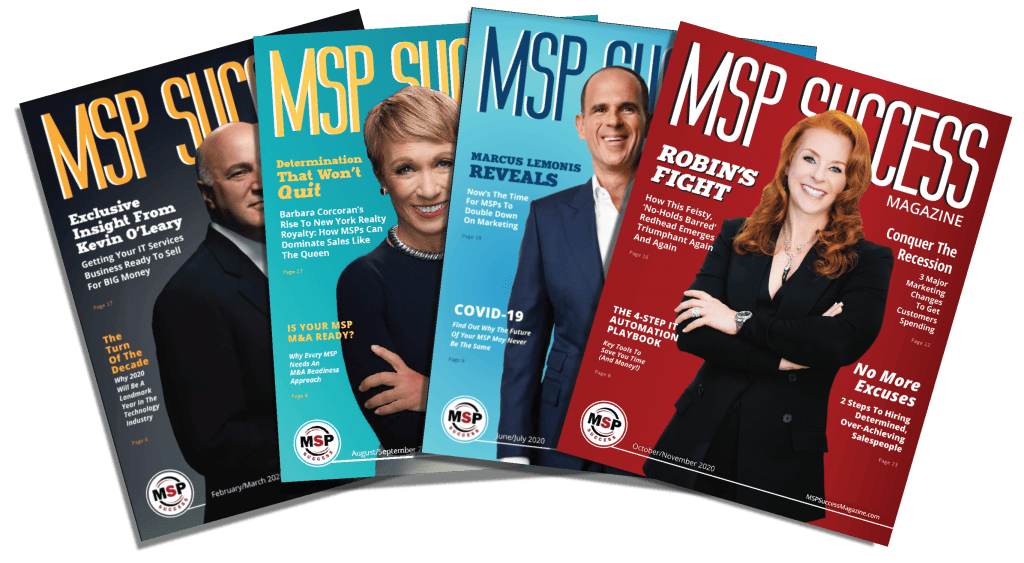“I need to cancel my contract.”
“Can I defer my payment to you for a couple of months?”
“I can’t pay you right now.”
“I can stay with you, but I need to shrink the amount we are paying you.”
How do you deal with these situations… or the radio silence clients give you when it comes to collecting a payment that is due?
Technology Marketing Toolkit Founder Robin Robins sat down with American businessman, author, and former FBI hostage negotiator Chris Voss for an engaging conversation about how to negotiate with clients who refuse to pay you. In part 1 of our 2-part series, we’ll reveal CEO of The Black Swan Group and co-author of Never Split the Difference: Negotiating As If Your Life Depended On It, Chris Voss’ three-step process for how you can preserve your relationship with your clients and get paid.
Before we get into the process, it’s important to recognize that people are in what Voss calls “crisis negotiation” mode due to COVID-19 and the effect this has had on our economy. During a crisis, people shift into survival mode. This can trigger decisions that they wouldn’t normally make. “We are not naturally wired to succeed,” Voss said. “We are wired to survive.”
While in certain situations it may make sense to accommodate and compromise, Voss cautioned against caving too quickly. “Everyone is being forced to ramp up their IT right now,” Voss said. “You’re selling shovels in the gold rush because you are selling the tools that everybody needs.”
At the same time, you want to be cautious about how you negotiate. Because your business depends on long-term client relationships, Voss recommends tailoring your approach to preserve the relationship. During negotiations, you’ll want to help your client avoid making a bad decision that will compromise his security while simultaneously preventing putting your company in jeopardy. “With patience, and demonstrated understanding, you remain the invaluable partner as people work their way through this,” Voss said.
This will work for every MSP, VAR, and IT provider… no matter what industry you work in. It doesn’t matter if you are talking to clients in the hospitality industry, medical industry, or law industry, etc. It will work in EVERY situation.
Here’s Voss’ 3-step process:
Step 1: Demonstrate understanding in your opening. Whether a client is calling you or you are reaching out to your client, you must start by demonstrating awareness and understanding. The economic toll from state shutdowns and mandated state-at-home orders has been staggering. Voss advised to stop asking, ‘How are you?’ when you know things are not going okay. “Asking ‘how are you’, while well-intentioned, demonstrates you are either oblivious or you don’t care,” Voss said.
Instead, start all conversations demonstrating you understand and are genuinely concerned for your client. Asking a question such as “What have I caught you in the middle of?” demonstrates you understand and that you are sharper than everybody else they are dealing with.
Voss emphasized that how you say things, the inflection in your voice and the words you use are crucial to your success. “What we are communicating with our voices in the midst of a crisis is massively important,” Voss said.
Step 2: Kick it up a notch. You’re going to use negotiation labels that start with “it seems like,” “it sounds like,” “it looks like,” however right now, he recommends you kick it up a notch by adding… “I know.” Fearlessly call out what is happening and acknowledge that people are afraid this going to destroy them and their company. “This is a time to say… ‘I know you’re scared… I know you’re angry,” Voss said.
When you do this, you will trigger people to align with you. “People are wired to collaborate with people,” Voss said. “You’ll build a relationship by collaborating, which calms people down and makes them want to work with you. “
It’s important to note that during every step, you want to preserve people’s autonomy and shift people into success mode.
Step 3: Ask thought shaping questions. The next step is to ask either a “how” or “what” question. “People loved to be asked “how” and “what” in deferential tones of voice,” Voss explained. “It makes them feel safe.”
These questions are designed to get people to expand their thinking about a topic or an issue. Voss says you must ask questions that get them to think in terms of the collaborative process because ultimately people are going to choose who they feel most comfortable with in going forward in the future. “Everyone is wondering who do they want to be in a foxhole with,” Voss said. By demonstrating awareness and understanding, and focusing on collaboration, your clients are more likely to identify you as the one they want to go shoulder to shoulder with to get through this to the other side.
“How?” example: “How do we work our way through this without destroying each other and leave ourselves in a position to pick up the pieces when this is all over?”
“What?” example: “What can we agree to as we work our way through this crisis?”
This is designed to make them feel comfortable. By using an upward inflection in your voice and demonstrating genuine curiosity, this question is highly collaborative.
Voss stressed the importance of your tone of voice when asking questions. “It hits people on a subconscious level, a conscious level, and impacts their brain to think,” Voss said. Use a calming and soothing voice to make people comfortable in communicating with you and collaborating with you. When your client is in crisis, Voss recommends defaulting to what he describes as “the late-night DJ voice” 90% of the time and use your “smile tone of voice” the other 10%. (When not in crisis, tone of voice is opposite. 90% smile and 10% DJ voice.)
“It’s not emotions that are bad for decision-making,” Voss said. “It’s negative emotions. Positive emotions enhance decision-making.” So during this time of crisis negotiation, remember to immediately demonstrate awareness and understanding. Make your MSP clients feel secure and comfortable and let them know you want to collaborate with them. This will make you more likeable and increase your odds of not only preserving your relationship, but getting paid.












